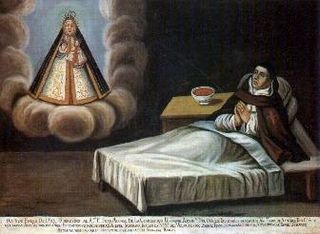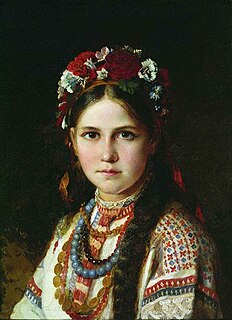
The Advent wreath, or Advent crown, is a Christian tradition that symbolizes the passage of the four weeks of Advent in the liturgical calendar of the Western church. It is traditionally a Lutheran practice, although it has spread to many other Christian denominations.

The Coat of Arms of Victoria is the official symbol of the Australian state of Victoria. Victoria was the second state of Australia to gain arms, granted on 6 June 1910 by royal warrant of King George V. The state had been named in 1851 after his grandmother, who was Queen at the time. Following the adoption of the pink heath as Victoria's floral emblem, Queen Elizabeth II signed a royal warrant on 28 March 1974 adding a Compartment from which the heath could grow. Although the rest of the arms remained the same in the blazon, certain elements were reinterpreted.

The Civic Crown was a military decoration during the Roman Republic and the subsequent Principate, regarded as the second highest to which a citizen could aspire. It took the form of a chaplet of common oak leaves woven to form a crown. It was reserved for Roman citizens who saved the lives of fellow citizens by slaying an enemy on a spot held by the enemy that same day. The citizen saved must admit it; no one else could be a witness.

The Divine Mercy of Jesus, also known as the Divine Mercy, is a Roman Catholic devotion to Jesus Christ associated with the apparitions of Jesus to Saint Faustina Kowalska. The Roman Catholic devotion and venerated image under this Christological title refers to what Faustina's diary describes as "God's loving mercy". Saint Faustina was granted the title "Secretary of Mercy" by the Holy See in the Jubilee Year of 2000.
Sister Faustina Kowalska reported a number of apparitions during religious ecstasy which she wrote in her diary, later published as the book Diary: Divine Mercy in My Soul. The three main themes of the devotion are to ask for and obtain the mercy of God, to trust in Christ's abundant mercy, and finally to show mercy to others and act as a conduit for God's mercy towards them.

First Communion is a ceremony in some Christian traditions during which a person first receives the Eucharist. It is most common in the Latin Church tradition of the Catholic Church, as well as in many parts of the Lutheran Church and Anglican Communion. In churches that celebrate First Communion, it typically occurs between the ages of seven and thirteen, often acting as a rite of passage.

The Chaplet of the Divine Mercy, also called the Divine Mercy Chaplet, is a Christian devotion to the Divine Mercy, based on the Christological apparitions of Jesus reported by Saint Faustina Kowalska (1905–1938), known as "the Apostle of Mercy." She was a Polish religious sister of the Congregation of the Sisters of Our Lady of Mercy and canonized as a Catholic saint in 2000.
Prayer beads are used by members of various religious traditions such as Hinduism, Buddhism, Christianity, Islam, Sikhism and the Bahá'í Faith to mark the repetitions of prayers, chants or devotions, such as the rosary of the Blessed Virgin Mary in Catholicism, and dhikr in Islam.

A laurel wreath is a round wreath made of connected branches and leaves of the bay laurel, an aromatic broadleaf evergreen, or later from spineless butcher's broom or cherry laurel. It is a symbol of triumph and is worn as a chaplet around the head, or as a garland around the neck. The symbol of the laurel wreath traces back to Greek mythology. Apollo is represented wearing a laurel wreath on his head, and wreaths were awarded to victors, both in athletic competitions. This includes the ancient Olympics — for which they were made of wild olive tree known as "kotinos" (κότινος), — and in poetic meets; in Rome they were symbols of martial victory, crowning a successful commander during his triumph. Whereas ancient laurel wreaths are most often depicted as a horseshoe shape, modern versions are usually complete rings.

The Chaplet of Saint Michael the Archangel, also called the Rosary of the Angels is a chaplet resulting from a reported private revelation by the Archangel Michael to the Portuguese Carmelite nun Antónia d'Astónaco. It was approved by Pope Pius IX in 1851.

A wreath worn for purpose of attire, , is a headdress made of leaves, grasses, flowers or branches. It is typically worn in festive occasions and on holy days and has a long history and association with ancient pageants and ceremonies. Outside of occasional use, the wreath can also be used as a crown, or a mark of honour. The wreath most often has an annular geometric construction.

The Ukrainian wreath is a type of wreath which, in traditional Ukrainian culture, is worn by girls and young unmarried women. The wreath may be part of a tradition dating back to the old East Slavic customs that predate the Christianization of Rus. The flower wreath remains a part of the Ukrainian national attire, and is worn on festive occasions and on holy days and since the 2014 Ukrainian revolution increasingly in daily life.

Marie Martha Chambon was a Roman Catholic nun known for introducing the Rosary of the Holy Wounds.

Rosary-based prayers are Christian prayers said on a set of rosary beads, among other cords. These prayers recite specific word sequences on different parts of the rosary beads. They may be directed at Jesus Christ, the Virgin Mary or God the Father.

The Rosary of the Seven Sorrows, also known as the Chaplet of Seven Sorrows or the Servite Rosary, is a Rosary based prayer that originated with the Servite Order. It is often said in connection with the Seven Sorrows of Mary.

Saint Michael the Archangel is referenced in the Old Testament and has been part of Christian teachings since the earliest times. In Catholic writings and traditions he acts as the defender of the Church, and chief opponent of Satan; and assists souls at the hour of death.

The Chaplet of the Five Wounds of Jesus or the Little Chaplet of the Five Wounds of Jesus Crucified is a devotional prayer written in 1761 by St. Alphonsus Liguori, a devotional writer and founder of the Redemptorist Fathers religious community.

O Blood and Water, also known as conversion prayer, is a prayer to the Divine Mercy revealed by Jesus to saint Faustina Kowalska.
Divine Mercy in Song is a project of Trish Short, founder of the nonprofit organization Artists for Life. After composing a contemporary version of the Divine Mercy prayer, her song became widely used for this rosary prayer.













